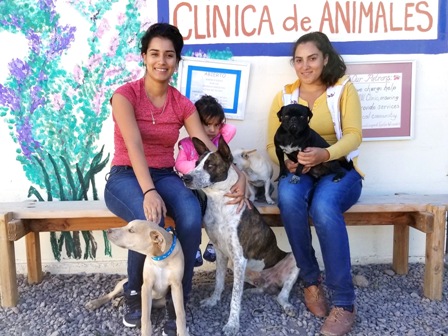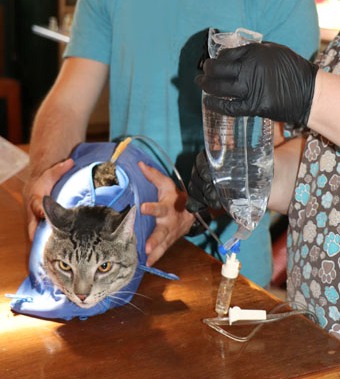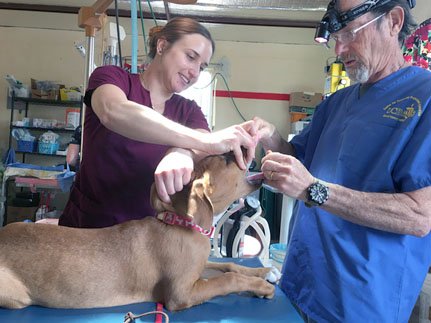Veterinary clinic protects the environment
MULEGÉ
What does a veterinary clinic have to do with the environment? That was a question I asked myself about 15 years ago when I traded my advisory role at a local youth environmental group to volunteer for a backyard spay-neuter clinic in this small desert town on the coast of the Baja California Peninsula.
Working with about 20 foreign volunteers at the Patrons of Animal Welfare (PAW) Veterinary Clinic run by a U.S. expat veterinarian, it didn’t take long to see that our group definitely had taken on a global environmental issue at a local level: improving the health of pets and containing their population.
Pets by the Numbers
In the 2016 census, Mexico’s National Institute for Statistics and Geography (INEGI in Spanish) reported that seven of every 10 households have pets but about 13.7 million (or 70 percent) of these 19.5 million cats and dogs live on the streets. The number of dogs is estimated to have increased by 20 percent since 2010.
About half a million animals are abandoned each year. According to INEGI, one of the main reasons for this is economic. Many are also abandoned within months of the holiday season after the novelty of a new gift pet wears off and the reality of daily responsibility for it becomes clear.
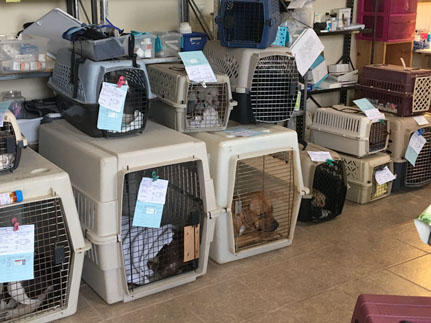
Full house: space is tight post-surgery during spay-neuter campaigns. Click to enlarge. (Photo: Debra Valov).
When I first started spending time in Mulegé, as far back as 1990, the town had a notable population of stray dogs. Dogs were commonly dropped off at tourist beaches, and campers were left to feed them or watch them starve.
The problem with strays
Both cats and dogs can spread disease or parasites in their feces, in bedding, and through physical contact with fur, mucosal membranes and sexual contact. Some of these can even affect humans.
The list includes: mange, fleas and ticks, worms (hook, pin, tape, heart), ringworm (a fungal infection), Transmittable Venereal Disease (dog to dog), viruses and bacterial infections (Parvovirus, Leptospirosis, Distemper and Feline Panleukopenia ).
Whether all the wandering dogs in town back in the 1990s had owners was not fully known, but dogs were on every corner, lying in the street, sunning themselves in the winter months or wedged under cars to escape the blazing sun the rest of the time, fighting each other or ganging up on a female in heat, overturning garbage containers and making messes all over the place. Dead animals on the highway, which runs through a number of the town’s neighborhoods, were an everyday experience.
Neglect and outright abandonment of cats are also big problems in both Mulegé and the peninsula, where their historic role is less as pet, more as a means of pest control.
“Cats are independent…they can fend for themselves...they will be fine outside on their own.” These are all common misconceptions around the world about domesticated cats, which, if left on their own, their reproduction unchecked and their health unattended, can wreak havoc on local fauna and create an unhealthy environment for everyone, as their population soars rapidly.
Within two years, a single fertile female and her fertile female offspring could produce up to 200 individuals.
Media reports often blame domestic pet cats for the decline of native species around the globe. While it is difficult to assess the exact numbers of birds, reptiles and mammals killed each year by cats, estimates show that feral cats account for about 75 percent of the 1-4 billion birds and 90 percent of the 6-22 billion mammals killed each year in North America [1]. Of the victims, 75-100 percent are thought to be native species. A data breakdown for Mexico does not seem to be available.
In a unique and delicately balanced desert ecosystem such as exists across most of the Baja California Peninsula, where food and water resources are limited, native mammals, amphibians, and reptiles are not found in abundant numbers. This means that the loss of a small number of breeding individuals could have a substantial impact on the health of any given local species.
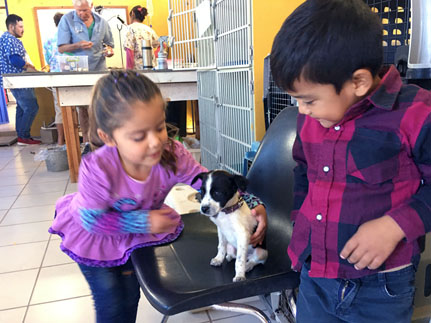
Promoting responsible pet ownership from an early age is a vital part of our work. Click to enlarge. (Photo: Debra Valov).
Non-venomous snakes, lizards, voles, kangaroo mice, rabbits, gophers, ground squirrels and a variety of bird species are among the common victims of cats in our area. And not all species injured or killed by cats end up as food items.
The cat population in Mulegé is unknown. What is clear is that the population goes through cycles, as does the number sterilized each year. A huge impediment to controlling the cat population is that many of our clients are unable to touch, let alone handle, their cats or catch them for transport to the clinic. Clinic volunteers may need to go out into the field now and then to help residents trap feral cats in their neighborhoods.
The Current Situation
We have an active visiting veterinarian program five months of the year. Vets from the United States, Canada and beyond come to volunteer their skills during a spay-neuter campaign in exchange for housing and a vacation. We also have terrific financial support from the foreign community which makes possible much of our work.
Education is a big part of the clinic’s mission, especially about the benefits of sterilizing and vaccinating one’s pets. Day to day personal contact with both pet owners and others in the community has been effective in spreading the message. This year we have finally been successful in recruiting a number of local volunteers.
We’ve seen a change in attitudes towards sterilization since 2006, when men were quite willing to spay their female dogs but wouldn’t even consider neutering their males. While that attitude hasn’t gone away completely, we have seen a gradual change over the years and now we regularly neuter about one male dog for every two females spayed.
Ten years of data show that over 10,400 animals have received some form of veterinary treatment, with almost 3,200 sterilizations; 1,990 of these were females. About 8,000 rabies vaccines were administered to dogs and cats.
In the last five of the 13 years that I’ve been involved with PAW, we have seen the most tangible results. Clients and others familiar with Mulegé tell us that many fewer stray dogs are on the streets and those that they do see tend to have collars and look healthy.
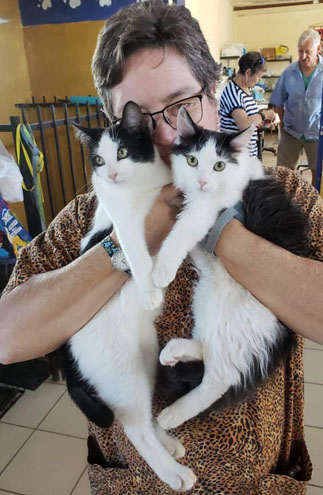
Author in her managerial role, the work of daily juggling often akin to herding kittens. Click to enlarge. (Photo: Courtesy of PAW).
A major concern for us in making gains or even just maintaining the current pet population, is the reality that natural disaster is lurking just around the corner. We've been fortunate to have fully recovered three times after the clinic was damaged and equipment lost from flash flooding at its original location. But the damage goes beyond just our facilities to disrupt the social fabric, with residents struggling to recover from property damage and income loss. Pets can take a back burner in these situations.
Since 2009, we have grown and thrived and the population of animals has appeared to have stabilized or declined. But now faced with the Covid-19 pandemic, which necesitated the cancellation of our final spay-neuter campaign for Spring 2020, we worry that economic factors impacting our neighbors may erase much or all of the gains we as a clinic and community have made, and that the town will see an increase in stray and abandoned kittens and puppies, and a concomitant decrease in the community's overall health.
As volunteers, we are reminded daily by local residents and visitors alike that the clinic provides an important and necessary service to our adopted community. I like to think that we are also doing our small part in making our
planet a better place, one cat or dog at a time.
Patrons of Animal Welfare (PAW) Animal Clinic
1 Loss, S., Will, T. & Marra, P. (2013). The impact of free-ranging domestic cats on wildlife of the United States. Nat Commun 4, 1396. [disponible a: https://www.nature.com/articles/NCOMMS2380]

